Fornax constellation lies in the southern hemisphere of the sky. Its name means “the furnace” in Latin. Fornax is one of the constellations added by the French astronomer Nicolas Louis de Lacaille in the mid-18th century. There are no myths associated with it.
Fornax is a relatively obscure constellation, with only one star brighter than magnitude 4.0. It is notable for the bright galaxies in the Fornax Cluster, including the Great Barred Spiral galaxy (NGC 1365), Fornax A (NGC 1316), the Fornax Dwarf, and UDFy-38135539, the galaxy that is the second most distant object in the universe to be observed.
Facts, location and map
Fornax is the 41st largest constellation in the sky, occupying an area of 398 square degrees. It is located in the first quadrant of the southern hemisphere (SQ1) and can be seen at latitudes between +50° and -90°. The neighboring constellations are Cetus, Eridanus, Phoenix and Sculptor.
The constellation name Fornax is pronounced /ˈfɔːrnæks/. In English, the constellation is known as the Furnace. The genitive form of Fornax, used in star names, is Fornacis (pronunciation: /fɔːrˈneɪsɪs/). The three-letter abbreviation, adopted by the International Astronomical Union (IAU) in 1922, is For.
Fornax belongs to the Lacaille family of constellations, along with Antlia, Caelum, Circinus, Horologium, Mensa, Microscopium, Norma, Octans, Pictor, Reticulum, Sculptor, and Telescopium.
Fornax contains four stars with known planets and no Messier objects. The brightest star in the constellation is Alpha Fornacis, with an apparent magnitude of 3.85. There are no meteor showers associated with the constellation.
Fornax contains three formally named stars. The star names approved by the International Astronomical Union (IAU) are Dalim, Diya, and Intan.
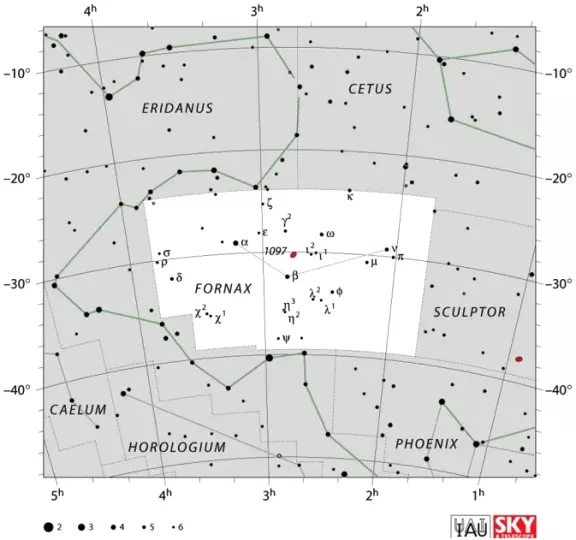
Fornax constellation map by IAU and Sky&Telescope magazine
Story
Fornax was introduced by Nicolas Louis de Lacaille in 1756, after his trip to the Cape of Good Hope, where he observed the southern stars and constellations.
Lacaille originally named the constellation Fornax Chemica, the chemical furnace, after the small fuel heater used for chemical experiments.
It was the English astronomer Francis Bailey who shortened the constellation’s name to Fornax at John Herchel’s suggestion in 1845.
Fornax stars
Dalim – α Fornacis (Alpha Fornacis)
Alpha Fornacis is the brightest star in the constellation and the only star brighter than magnitude 4.0. It is a subgiant star belonging to the spectral class F8IV. It has an apparent magnitude of 3.85 and is approximately 46 light years distant from the solar system.
The star has the traditional names Dalim and Fornacis. It is 33% more massive than the Sun and is believed to be about 2.9 billion years old.
Alpha Fornacis is really a binary star, and it may have a circumstellar disk of debris, as it exhibits an excess of infrared emission.
β Fornacis (Beta Fornacis)
Beta Fornacis is a giant star belonging to the spectral class G8.5IIIb. It has a visual magnitude of 4.465 and is approximately 169 light years distant. The star has an optical companion with a visual magnitude of 14.0.
λ2 Fornacis (Lambda-2 Fornacis)
Lambda-2 Fornacis is a main sequence star with the stellar classification G1V. It has an apparent magnitude of 5.78 and is 84.1 light years distant. It is about 300 million years younger than the Sun, and hotter and more massive. The star has a low mass extrasolar planet in its orbit.
HD 20781 and HD 20782
HD 20781 and HD 20782 form a wide binary system and both stars have their own planetary systems in S type orbits. This is the first binary star discovered with both components known to have orbiting planets.
HD 20781 has the stellar classification G9.5V and is approximately 117 light years distant from the solar system. It has an apparent magnitude of 8.44. It has two confirmed planets in its orbit. They were discovered in 2011.
HD 20782 belongs to the spectral class G3V. It has an apparent magnitude of 7.38 and is also approximately 117 light years distant. An extrasolar planet was discovered orbiting the star in 2006.
HIP 13044
HIP 13044 is a red horizontal branch star, one in the stage of evolution that follows the red giant stage. It has an apparent magnitude of 9.9 and is approximately 701 light years distant from Earth.
The star is part of the Helmi stellar association, an association in the Milky Way that started out as a dwarf galaxy and was absorbed by the Milky Way.
HIP 13044 is seven times the size of the Sun, but slightly less massive. It is believed to be about nine billion years old or possibly even older. A planet, designated HIP 13044 b, was discovered in the star’s orbit in November 2010.
HIP 13044 b is an exoplanet, a hot Jupiter that is believed to have originated outside the galaxy and then become part of the Milky Way when its galaxy of origin collided with and was absorbed by our galaxy.
Deep sky objects in Fornax
Fornax Cluster
The Fornax Cluster is a cluster of galaxies, most of which are located in the Fornax constellation. It is relatively small, yet it is the second richest galaxy cluster within 100 million light years. It has about 58 member galaxies.
The central galaxy in the cluster is NGC 1399. Other bright members of the cluster include NGC 1404 and NGC 1427A in the constellation Eridanus.
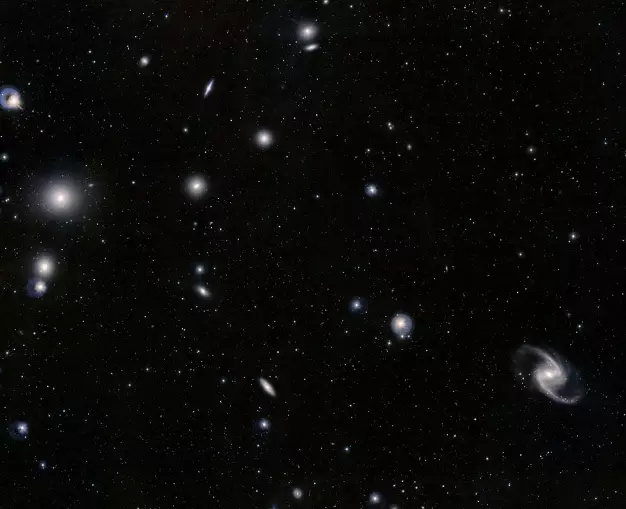
The Fornax Galaxy Cluster is one of the closest of such groupings beyond our Local Group of galaxies. This VISTA image was constructed from images taken through Z, J and Ks filters in the near-infrared part of the spectrum and has captured many of the cluster members in a single image. At the lower-right is the elegant barred-spiral galaxy NGC 1365 and to the left the big elliptical NGC 1399, surrounded by a swarm of faint globular clusters. Image: ESO, J. Emerson, VISTA. Acknowledgment: Cambridge Astronomical Survey Unit
NGC 1399
NGC 1399 is a bright, large elliptical galaxy located in the centre of the Fornax Cluster. It has a visual magnitude of 9.9.
NGC 1404
NGC 1404 is an elliptical galaxy in the Fornax Cluster. It has an apparent magnitude of 10.3 and is approximately 66 million light years distant from the Sun.
UDFy-38135539
UDFy-38135539 is another galaxy in Fornax. It has been identified as the second most distant object in the universe. It is 13.1 billion light years away from the Sun.
The galaxy was discovered in 2009, when its image was captured in the Hubble Ultra Deep Field.
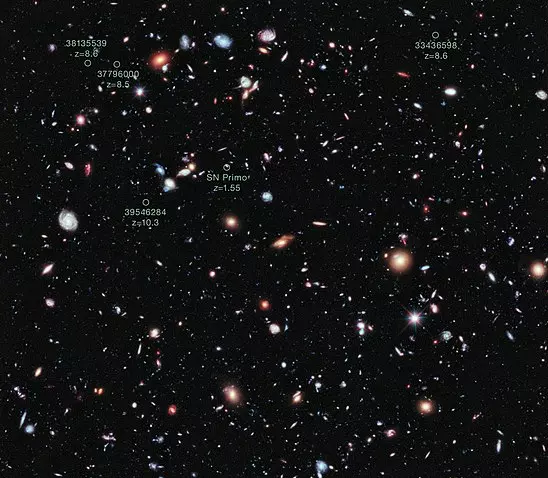
This image, called the Hubble eXtreme Deep Field (XDF), combines Hubble observations taken over the past decade of a small patch of sky in the constellation of Fornax. With a total of over two million seconds of exposure time, it is the deepest image of the Universe ever made, combining data from previous images including the Hubble Ultra Deep Field of 2002/3 and Hubble Ultra Deep Field infrared image of 2009. The image covers an area less than a tenth of the width of the full Moon, making it just a 30 millionth of the whole sky. Yet even in this tiny fraction of the sky, the long exposure reveals about 5,500 galaxies, some of them so distant we see them when the Universe was less than 5% of its current age. The Hubble eXtreme Deep Field image contains several of the most distant objects ever identified. Among these are: UDFj-39546284, at a redshift of 10.3, is a candidate for the most distant galaxy yet discovered, though it is awaiting spectroscopic confirmation, Supernova Primo, at a redshift of 1.55, the most distant type Ia supernova ever observed, UDFy-38135539, at a redshift of 8.6, is the most distant galaxy to have had its distance independently corroborated with spectroscopy, UDFy-33435698, at a redshift of 8.6. Image: NASA (Hubble Space Telescope)
It is the first galaxy to be observed during the reionization epoch, the period in Bing Bang cosmology between 150 million and one billion years after the Big Bang, when matter in the universe was reionized.
NGC 1097 (Caldwell 67)
NGC 1097 is a barred spiral galaxy in Fornax. It has an apparent magnitude of 10.2 and is approximately 45 million light years distant.
The galaxy is also classified as a Seyfert galaxy, one that has a nucleus that produces spectral line emission from highly ionized gas and is believed to have a supermassive black hole at its centre.
NGC 1097 has a couple of satellite galaxies, NGC 1097A and NGC 1097B. NGC 1097A is a peculiar dwarf elliptical galaxy and it orbits the larger galaxy 42,000 light years from the centre of NGC 1097. NGC 1097B is a dwarf irregular galaxy.
Three supernovae have been discovered in NGC 1097 in the last couple of decades: SN 1992bd in 1992, SN 1999eu in 1999, and SN 2003B in 2003.
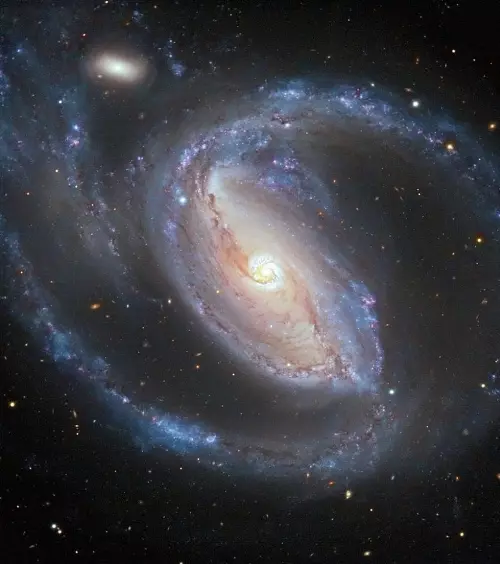
Two galaxies, about 50 million light-years away, are locked in a galactic embrace — literally. The Seyfert galaxy NGC 1097, in the constellation of Fornax (The Furnace), is seen in this image taken with the VIMOS instrument on ESO’s Very Large Telescope (VLT). A comparatively tiny elliptical companion galaxy, NGC 1097A, is also visible in the top left. There is evidence that NGC 1097 and NGC 1097A have been interacting in the recent past. Image: ESO, R. Gendler
NGC 1360
NGC 1360 is a planetary nebula in Fornax. It has an apparent magnitude of 9.4 and is about 700 light years distant. The central star has a visual magnitude of 11.4.
The nebula was discovered by the German astronomer Friedrich August Theodor Winnecke in January 1868.
Great Barred Spiral Galaxy – NGC 1365
NGC 1365 is a barred spiral galaxy in the Fornax Cluster. It has an apparent magnitude of 10.3 and is approximately 56.2 million light years distant. It spans about 200,000 light years.
The galaxy is also known as the Great Barred Spiral Galaxy because its structure and form appear perfect. It is one of the most studied barred spiral galaxies, and one of the best known.
Three supernovae have been observed in the galaxy: SN 1957C in 1957, SN 1983V in 1983, and SN 2001du in 2001.
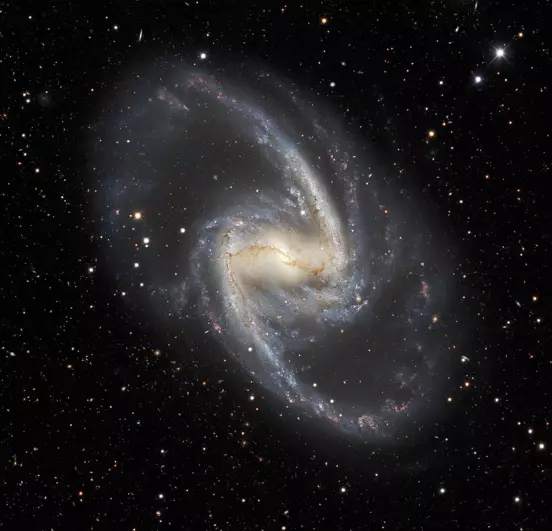
This image captures the elegant galaxy NGC 1365 in the Fornax Cluster of galaxies. Also known as The Great Barred Spiral Galaxy, NGC 1365 is a strikingly perfect example of a barred spiral galaxy. This image shows the galaxy’s prominent bar and its graceful spiral arms, with lanes of dust obscuring the extended diffuse glow of stars. The central bar of NGC 1365 influences star formation throughout the entire galaxy and conceals a supermassive black hole hidden behind multitudes of newly formed stars. Astronomers are interested in barred spiral galaxies like NGC 1365 for more than just their elegance — these galaxies provide insights into our home galaxy, the Milky Way, which is also a barred spiral galaxy. Image: Dark Energy Survey/DOE/FNAL/DECam/CTIO/NOIRLab/NSF/AURA; image processing: Travis Rector (University of Alaska Anchorage/NSF’s NOIRLab), Jen Miller (Gemini Observatory/NSF’s NOIRLab), Mahdi Zamani & Davide de Martin (NSF’s NOIRLab)
NGC 1398
NGC 1398 is a barred spiral galaxy about 135,000 light years in diameter. The galaxy is approximately 65 million light years distant. It is a member of the Fornax Cluster. A supernova, SN 1996N, was observed in the galaxy in 1996.
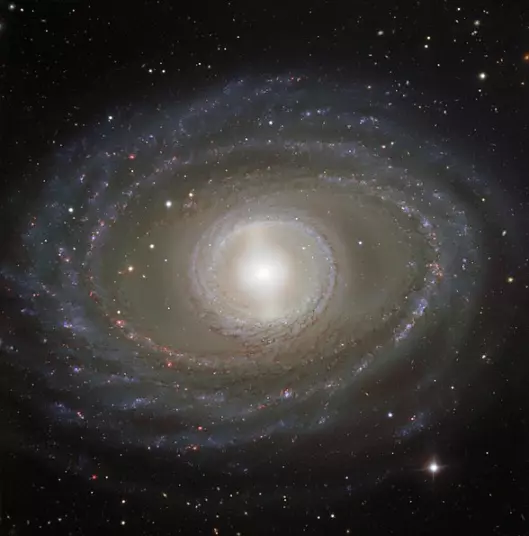
NGC 1398, image: ESO
NGC 1427
NGC 1427 is an elliptical galaxy in Fornax. It has a visual magnitude of 12.6 and is approximately 71 million light years distant. The galaxy is currently moving in the direction of the Fornax Cluster.
NGC 1049
NGC 1049 is a globular cluster approximately 630,000 light years distant from the solar system. It has an apparent magnitude of 12.9. The cluster is visible in moderate sized telescopes. It was discovered by the English astronomer John Herschel in the 1830s.
NGC 1049 is the largest of the six globular clusters located in the Fornax Dwarf.
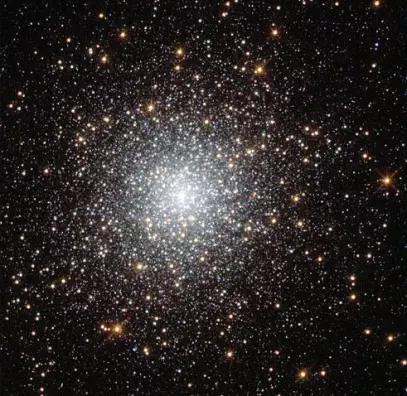
This NASA/ESA Hubble Space Telescope image shows the globular cluster Fornax 3 (NGC 1049) in the dwarf galaxy Fornax. New observations of this cluster and three others in the galaxy show that they are very similar to those found in our galaxy, the Milky Way. The finding is at odds with leading theories on how these clusters form — in these theories, globular clusters should be nestled among large quantities of old stars — and so the mystery of how these objects came to exist deepens. Image: NASA, ESA, S. Larsen (Radboud University, the Netherlands)
Fornax Dwarf
The Fornax Dwarf Spheroidal galaxy is an elliptical dwarf galaxy in Fornax. It has a visual magnitude of 9.3 and is approximately 460,000 light years distant.
The galaxy belongs to the Local Group and is a satellite of the Milky Way. It was first discovered by the American astronomer Harlow Shapley, who had also discovered the Sculptor Dwarf galaxy in the constellation Sculptor.
The Fornax Dwarf contains six globular clusters, the largest of which (NGC 1049) was discovered before the galaxy itself.
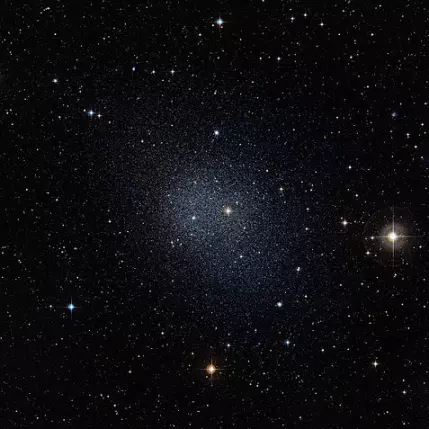
The Fornax Dwarf, image: ESO, Digitized Sky Survey 2
Fornax A – NGC 1316
Fornax A is a lenticular galaxy with an apparent magnitude of 9.4. It is approximately 62 million light years distant and lies in the Fornax Cluster. The galaxy appears to be interacting with a much smaller spiral galaxy, NGC 1317.
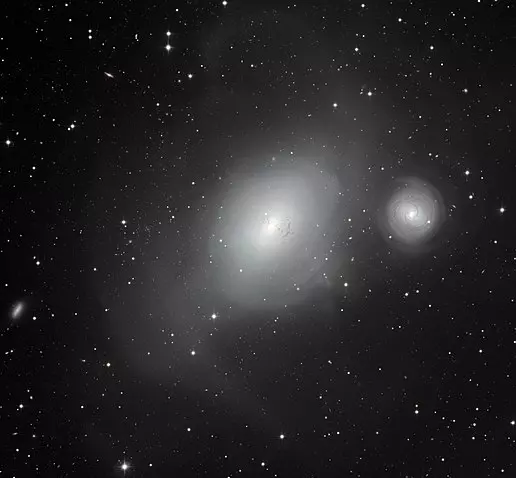
This image from the MPG/ESO 2.2-metre telescope at ESO’s La Silla Observatory in Chile shows a contrasting pair of galaxies: NGC 1316, and its smaller companion NGC 1317 (right). Although NGC 1317 seems to have had a peaceful existence, its larger neighbour bears the scars of earlier mergers with other galaxies. Image: ESO
NGC 1316 is classified as a radio galaxy, and is the fourth brightest radio source in the sky. Two supernova events were observed in the galaxy in recent decades: SN 1980N in 1980 and SN 1981D in 1981. Both were Type Ia supernovae.
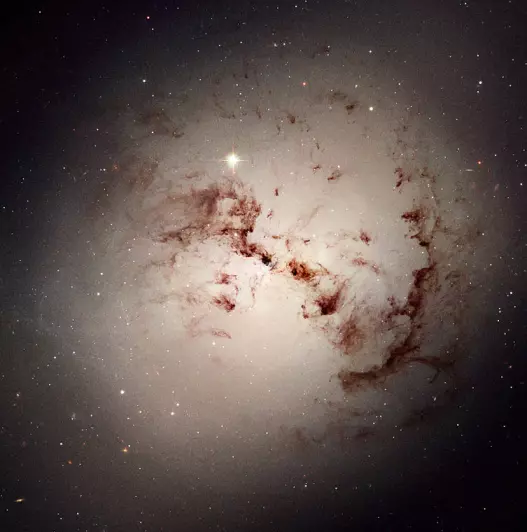
Fornax A – NGC 1316, image: NASA, ESA, and The Hubble Heritage Team
NGC 1350
NGC 1350 is a spiral galaxy in Fornax. It has an apparent magnitude of 11.46. The galaxy is notable for its pronounced ring structure. The galaxy’s spiral arms are wound pretty tightly and they form a pronounced central ring.
NGC 1350 is approximately 87.4 million light years distant. It is roughly 130,000 light years across, which makes it a bit larger than the Milky Way. The galaxy lies on the outskirts of the Fornax Cluster, but is not a member.
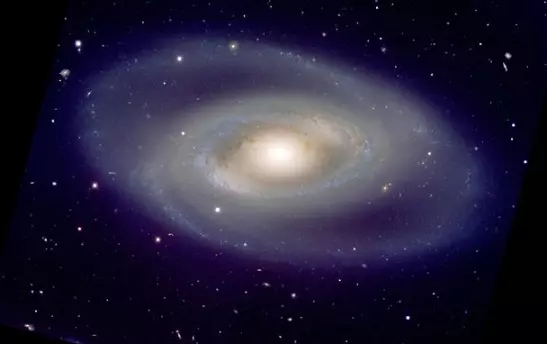
NGC 1350, image: ESO